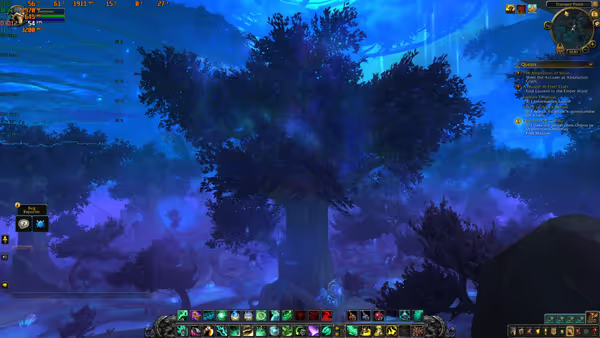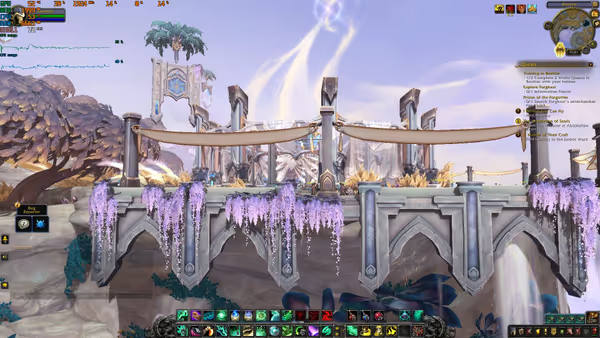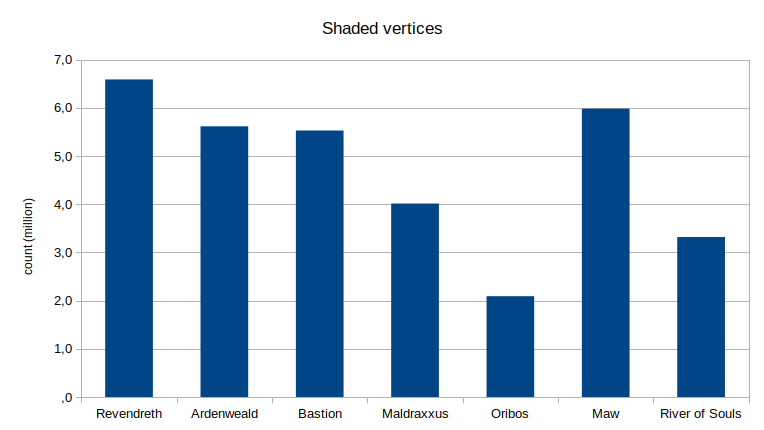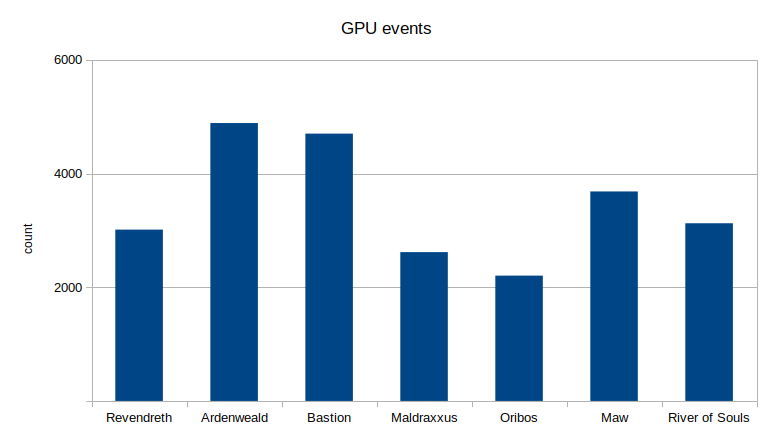World of Warcraft Shadowlands performance analysis
World of Warcraft does not have any benchmark mode. This makes it hard to provide reliable data on the game performance in various content types it offers. And it pretty much must be done by an active player which excludes this games from most external reviews and benchmarks.
Game performance, FPS, depends from many factors. First you camera position can impact the FPS - the more sky you put in your field of view and the less complex scenery the higher the FPS can get. Then you have other players or multiple NPCs, especially if they perform any actions. On top of that you can't really get identical results from raid boss pulls or from dungeon runs - as each pull is different then it's super hard to compare hardware that way. It just shows how given configuration performed in given runs (you would need a lot of runs for a good average). If you want current raid and dungeon benchmarks you should be watching for Hardware Numb3rs videos.
Over Legion, BfA and now Shadowlands I've tried to get some relatively repeatable and accurate benchmarking spots in the game. If you follow my instructions then your results should be fine to compare with those I've got or those that other players got in same conditions.
How to benchmark WoW?
Benchmarking apps
For my benchmarks I used MSI Afterburner to record average, 1% low and 0.1% low FPS of selected parts of gameplay. You can check how to use and configure Afterburner in the Tech Yes City afterburner setup video. It boils down to selecting parameters you want to display on the overlay as well as the benchmark start/stop hotkeys to log data to a text file.
MSI Afterburner can also be used to analyze hardware performance - like temperature, clocks, throughput and alike. This can help detect problems with like slight clock throttling on the GPU or CPU and alike
Benchmarking spots
There is few good spots to test combat and pure GPU performance of your system:
- Combat benchmark: Karazan TBC raid is good for combat testing. Pull multiple packs of mobs and let them smack you while you do your benchmarking. The FPS are usually lower to what you get in actual raid/dungeon as average framerate but represent very accurately the 1%/0.1% framerate - if you get bad framerate in Karazan it will occasionally happen in a real raid. This is heavily CPU dependent.
- Pure GPU load: Dazar'alor - looking at the harbor from the back of Great Seal gives a low-CPU, high-GPU scene that also response really well to render distance (and thus changing quality mode)
- Mixed I/O, GPU and CPU: doing few loops around Legion Dalaran is a good way to test how the system responds to rendering a bit more complex scene and loading lots of assets, handling random player activity.
For Shadowlands there can be few new spots specific to the expansion features, differences in zone to zone performance:
- Player hub - high CPU/GPU load: looking at the entrance to the Geat Seal in Dazar'alor in BfA was a good spot that put really high CPU/GPU load. For Shadowlands such spot likely will be somewhere in Oribos or in a sanctum of a popular Covenant. If you have good framerate then you system will handle big crowd of players, players hubs and alike.
- Ardenweald: a GPU demanding zone. I used a static view looking at one of trees at Tirna Vaal as well as flight between two flight points.
- Bastion, Maldraxxus: much less GPU demanding zones. Here similarly to Ardenweald I picked a static view and a flight between two points.
- The Maw: second GPU heavy zone. You can benchmark a widefield view of the zone, which will be bit lower than more common limited field of view. Flight benchmarks can be done by using transportation
pillars
spread across the zone. - River of Souls (The Maw): This spot is heavy on translucent effects and depending on camera position the performance can be much lower. I did most of my tests looking with the flow of the river at the western end of it.



Results analysis - 1% and 0.1% low framerate
Average framerate shows average system performance but doesn't show actual quality and feel of the gameplay. That's what 1% and 0.1% low FPS is trying to show. When system can't provide frames quickly enough then some frames will be on screen for longer. Those two metrics take the x % of longest lasting
frames. 40-100+ average FPS looks like the game is fluid but it actually can stutter or have noticeable slowdown moments which will be revealed by like 10-30 FPS on 1%/0.1% low FPS metric. If you see low values for them in game but acceptable current average framerate try rotating your camera - is is smooth or does it have weird
choppiness to it? Or maybe there are recurring stutter moments in-between fluid gameplay?
If you have good average FPS but low 1% FPS the it still can be quite fine to play. In best case scenario there will be less fluidity to like camera rotation but in worst case scenario you will feel stutter which quickly can become annoying. This is also important for high refresh displays - if your 1% low FPS is high then camera rotations and similar actions will feel really good and there will be a perceived difference between a 60Hz and 144Hz display. If the 1%/0.1% low is really low then you will loose some perceived fluidity of high refresh rate display.
Shadowlands performance
Shadowlands does not differ that much from previous expansion in terms of performance. We aren't getting Boralus or Dazar'alor this time. Oribos is smaller which should perform much better without the need for optimization game and GPU driver side. Zones are really detailed, although differ in style and fidelity.
Ardenweald and The Maw on the beta are noticeably more GPU demanding than other zones. Even when on the ground and not looking on a widefield view of the zone the GPU utilization can be high or even 100%. This can change as it's beta, but still Ardenweald is really detailed zone.
For raids, dungeons standard rule apply - combat is CPU bound. Still have to test if like Ardenweald dungeon is also GPU demanding on top of that.
Barrier to entry for WoW Shadowlands is relatively low. Whatever budget old/new GPU and somewhat decent CPU will do for 1080p WoW SL experience. If your GPU has problems then lowering the settings gives good response.
When increasing the resolution to 4K and 1440-ultrawide or super-ultrawide you will quickly need a top shelf GPU to have good framerate or even 1440p at high refresh rate without very low quality setting. Going above 100 FPS at such resolutions will need a good CPU as well, while for 1080p weaker CPUs will be ok, but may drop the FPS in mass-actor mass-event scenarios (large pulls, lots of players, mob casting mult-effect spell or spells in parallel).
Laptops, mobile systems are a bit of a different spot. Latest Ryzen 4000 and Intel G7 chips using integrated graphics should run the game fine, even or medium or custom higher settings. Older may struggle on iGPU - UHD 630 is the minimal requirement, while on top of that low power CPU may make it even worse than help. Dedicated graphic should help if the CPU isn’t really bad.
If you want to buy a laptop, especially ultra-portable, check reviews for it performance. Based on model it may be set to lower TDP and offering much lower performance that you could expect from the components.
Below are GPU statistics from Radeon GPU Profiler pulling data from Vega 64 running on a Threadripper 1920X with 32GB of quad-channel RAM:



RGP marked Ardenweald and The Maw as GPU bound (FPS limited by the GPU) while other (Oribos, Maldraxxus, Bastion, Revendreth) as CPU bound. Amount of shaded pixels is in-line with GPU load and lower FPS observed in those zones (GPU load hitting 100%).
Comment article